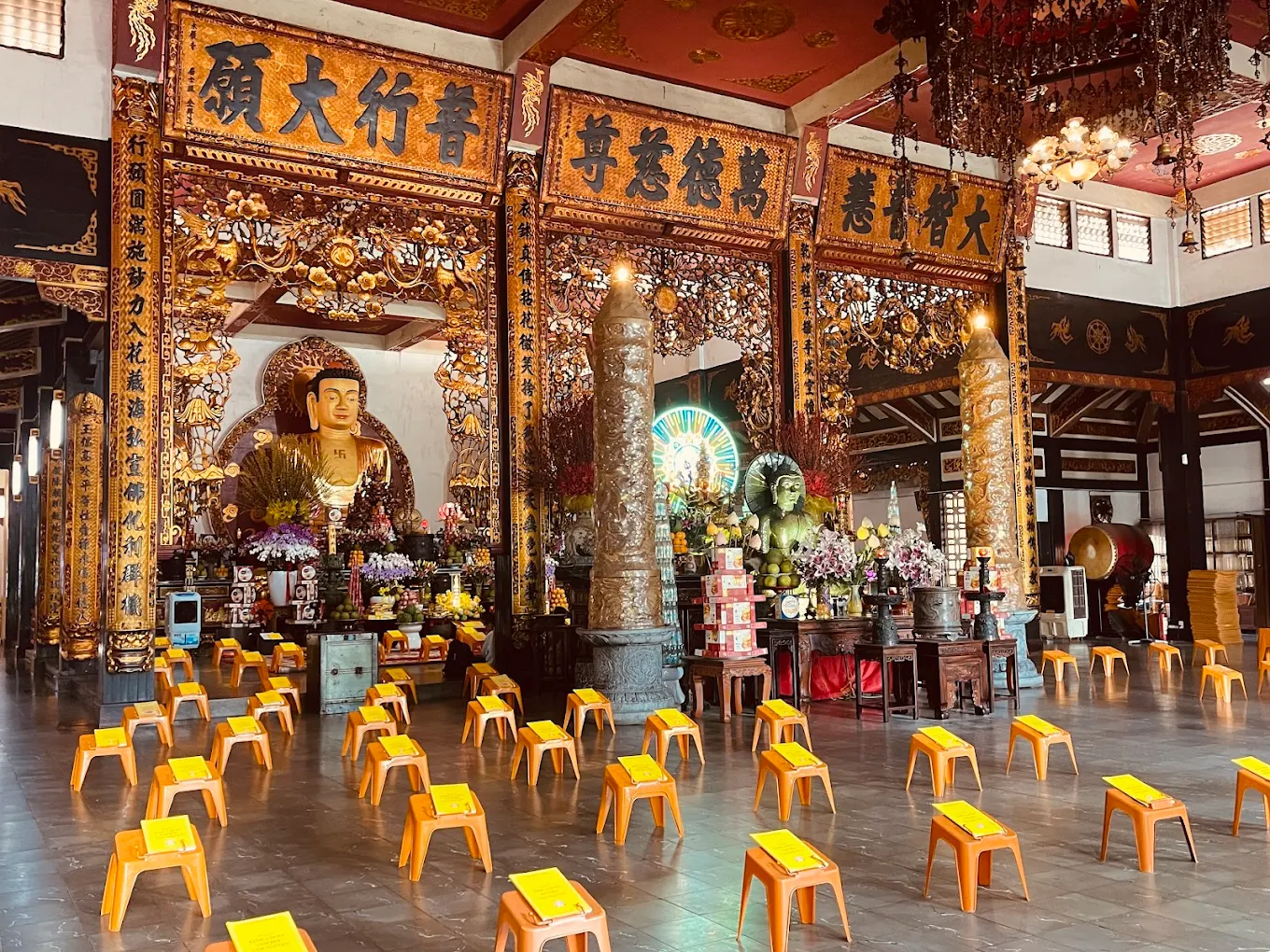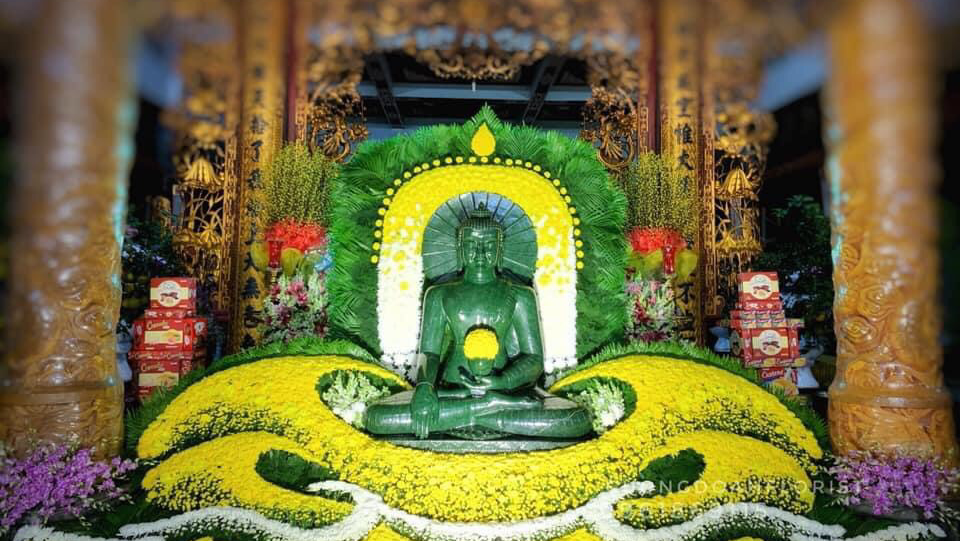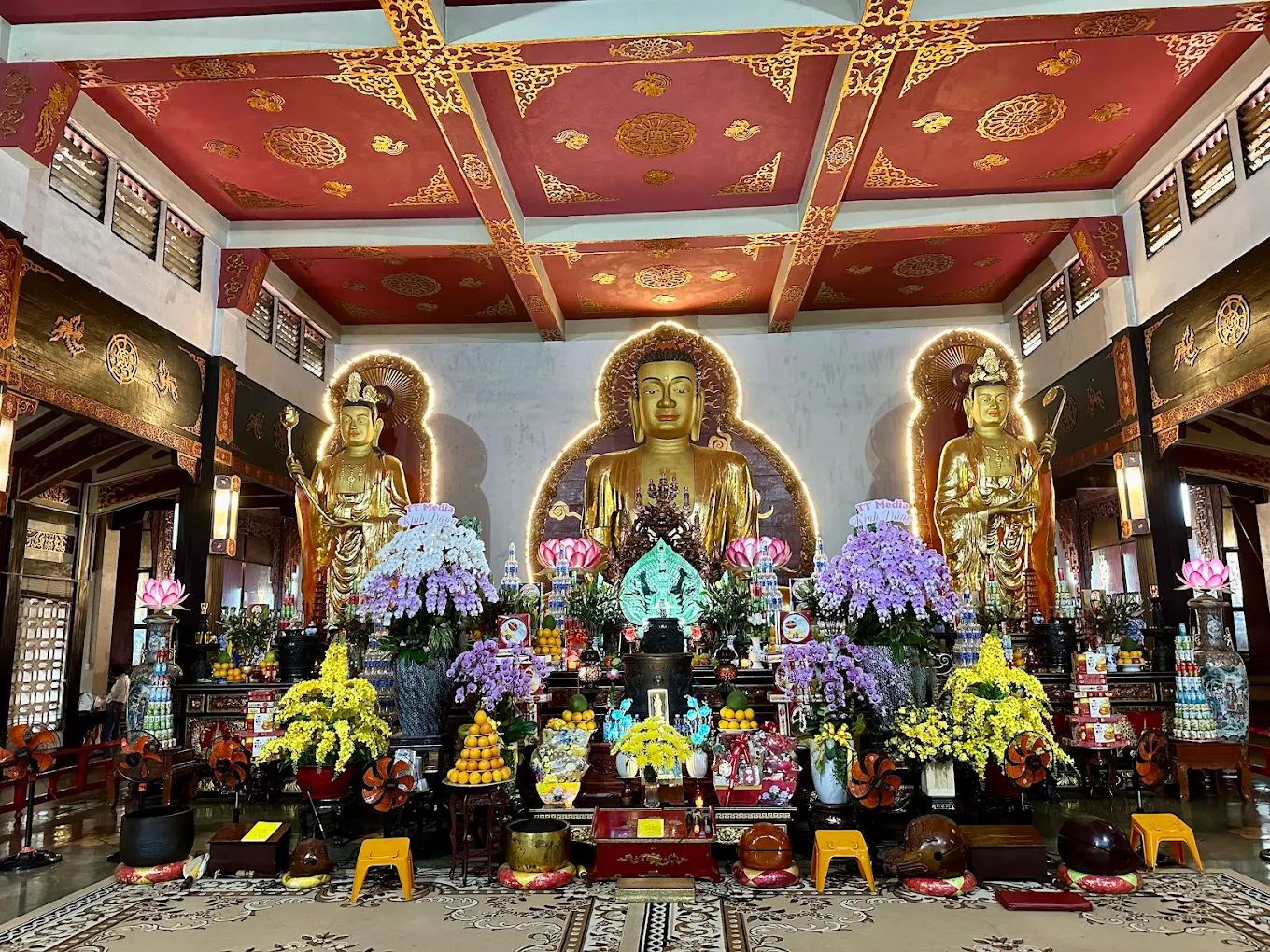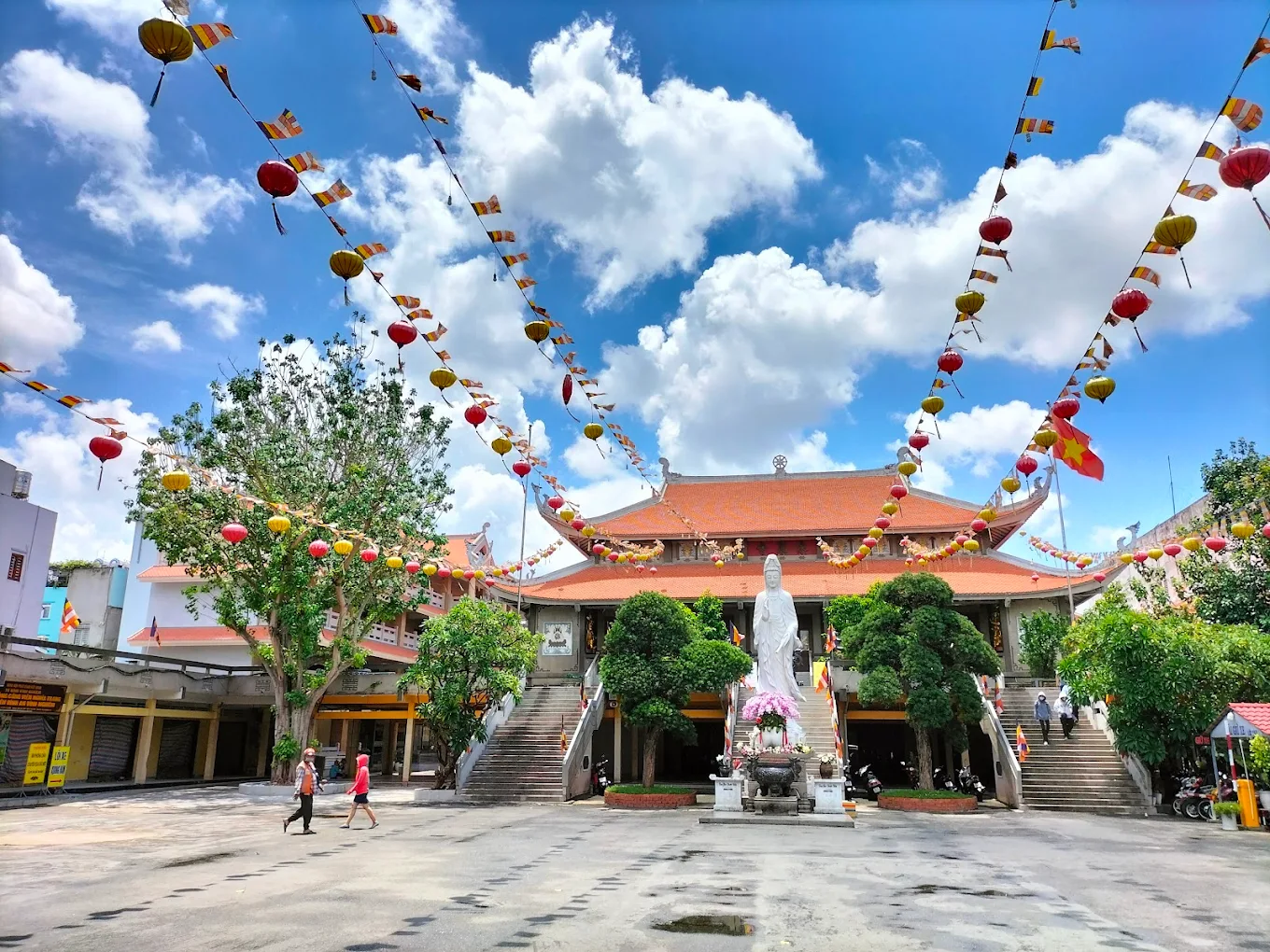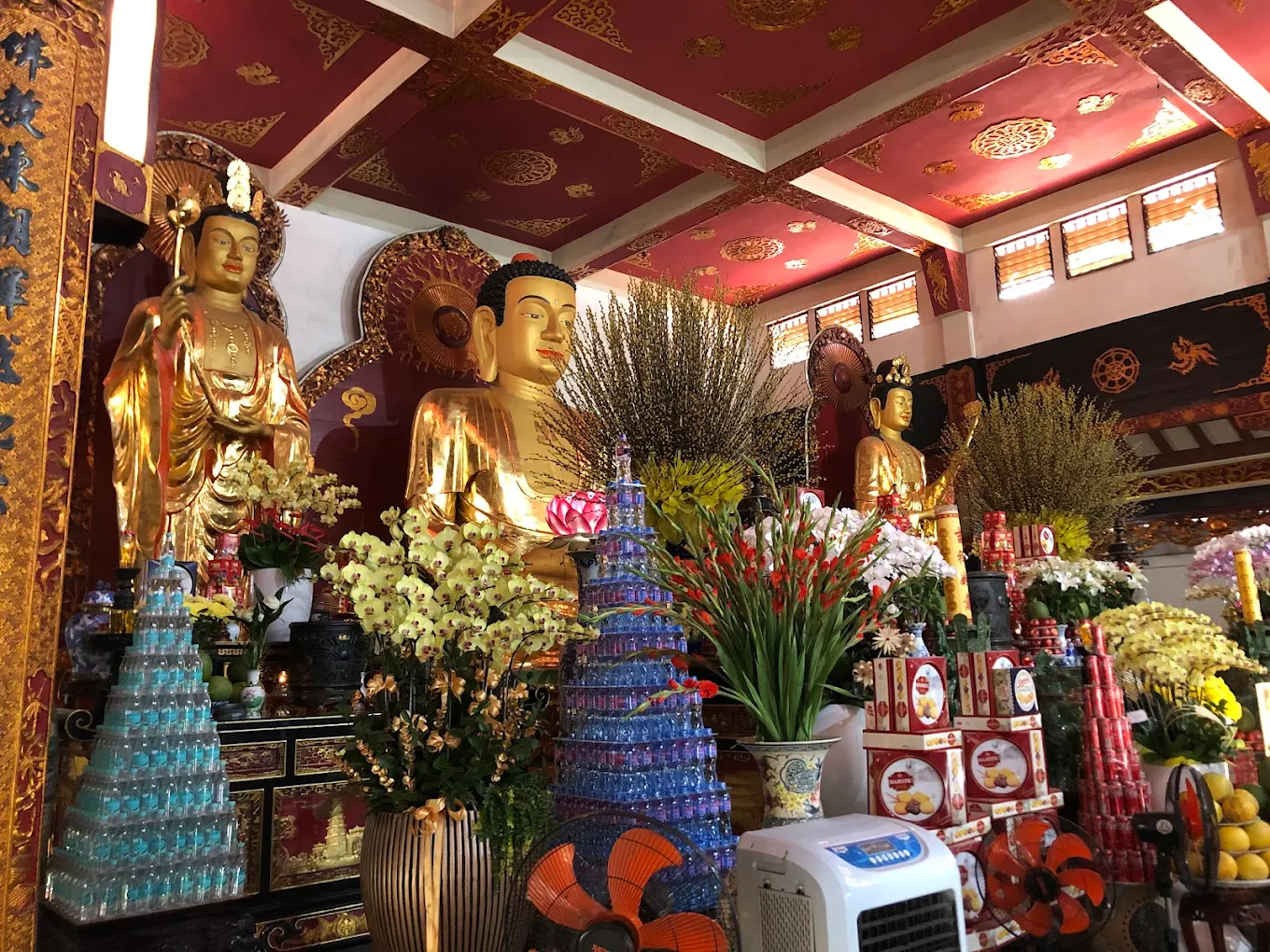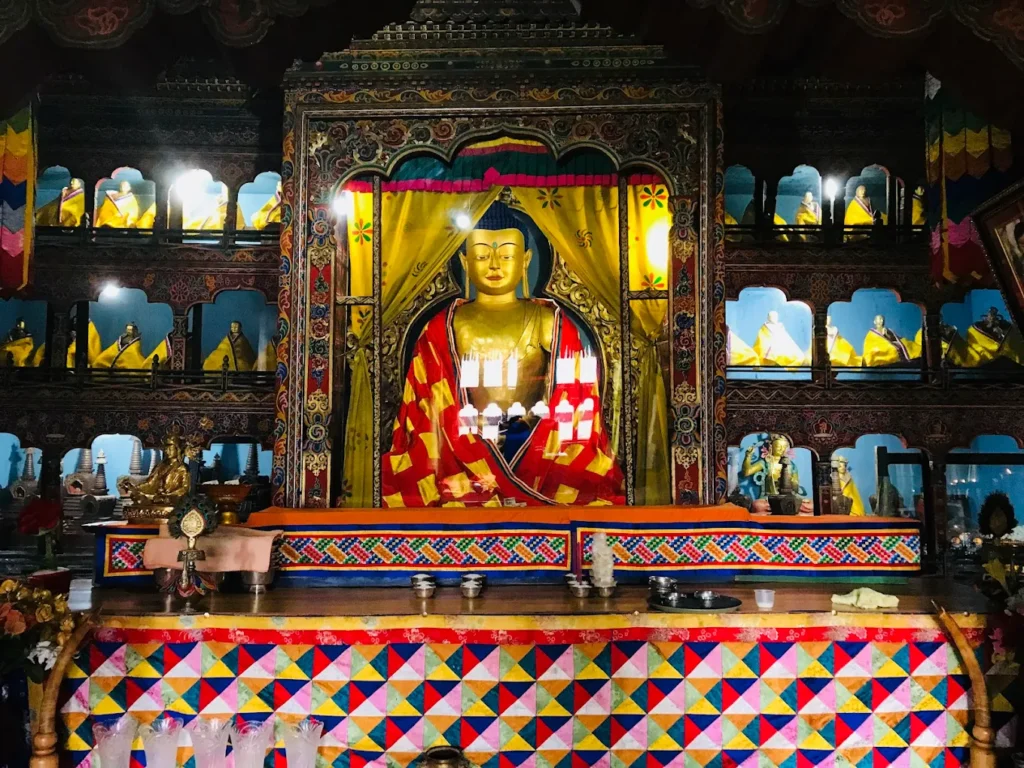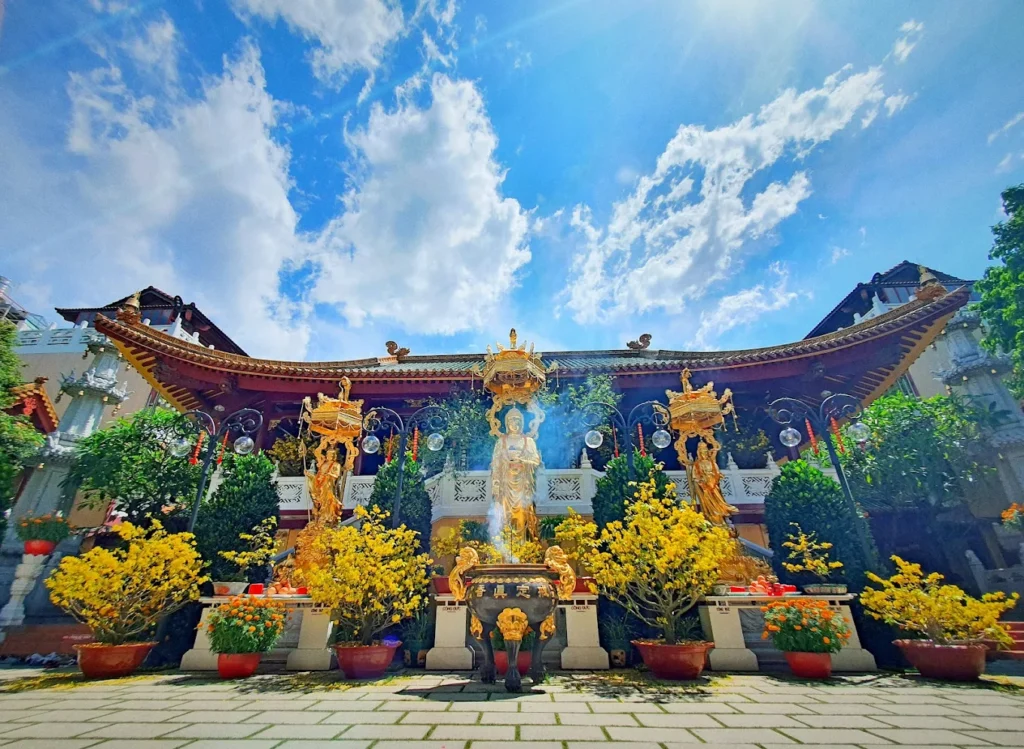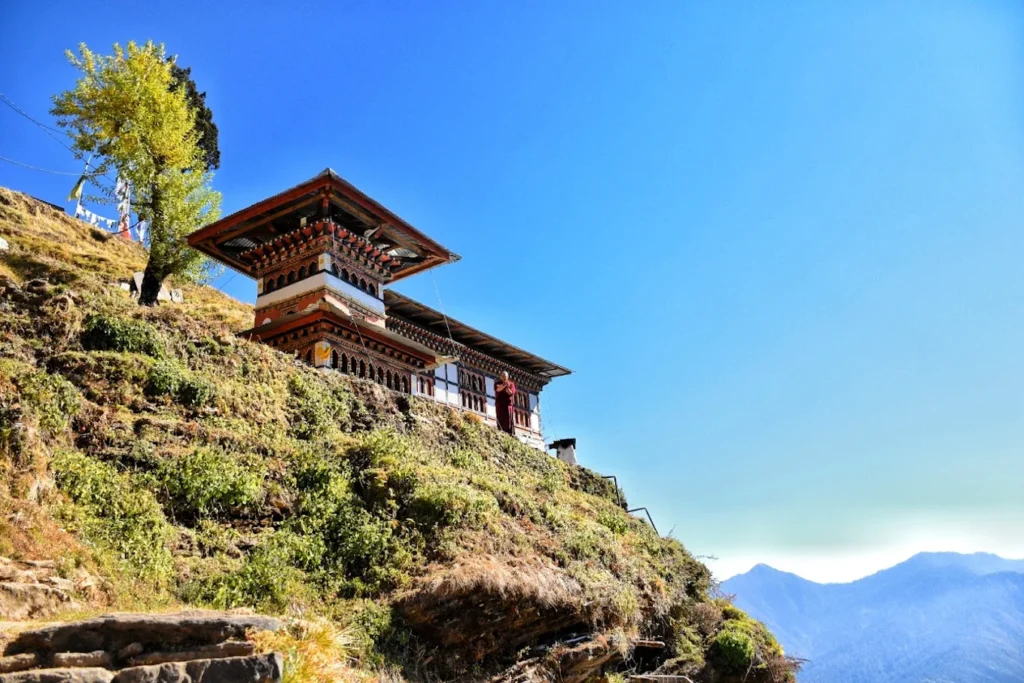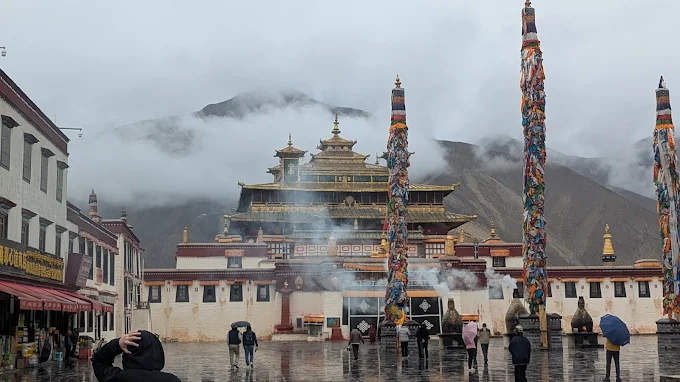Vinh Nghiem Pagoda: Saigon’s Majestic Citadel of Buddhist Devotion
Along Nam Kỳ Khởi Nghĩa Street in District 3, Vinh Nghiem Pagoda, founded in 1964 by Hòa thượng Thích Tâm Giác and Thích Thanh Kiểm, radiates majestic calm with its red-tiled roofs and soaring Avalokiteshvara Tower [Tháp Quán Thế Âm]. This Mahayana pagoda [chùa], spanning 6,000 square meters, blends Vietnamese architecture with a seven-story tower, its main hall [chánh điện] adorned with statues of Shakyamuni Buddha and Bodhisattvas. Hosting vibrant Vesak and Vu Lan festivals, it draws thousands to its lotus-filled courtyard. With charity programs and a Great Peace Bell [đại hồng chung] from Japan, the Vinh Nghiem Pagoda listing invites devotees and travelers to Ho Chi Minh City’s Buddhist soul.
Citadel of Devotion: Overview and Significance
Vinh Nghiem Pagoda, a Mahayana sanctuary in District 3, embodies spiritual devotion and cultural heritage, enriching the Vinh Nghiem Pagoda listing. Its historical legacy, architectural grandeur, and community outreach make it a cornerstone of Ho Chi Minh City’s Buddhist landscape.
Historical Roots and Legacy
Founded in 1964 and completed in 1971 by Thích Tâm Giác and Thích Thanh Kiểm, the pagoda was designed by Nguyễn Bá Lăng, inspired by the ancient Vinh Nghiem Pagoda in Bắc Giang from the Lý dynasty. Built on low land beside Thị Nghè Canal, it required extensive leveling. The Vinh Nghiem Pagoda listing reflects its role as a training center for monks and nuns, fostering Mahayana teachings.
- Key Milestones:
- 1964: Construction began in District 3.
- 1971: Completed with Avalokiteshvara Tower.
- Ongoing: Hosts charity and educational programs.
Cultural and Spiritual Significance
Rooted in Mahayana’s Northern School [Bắc Tông], a Vietnamese branch influenced by Chinese Buddhism, the pagoda emphasizes the Bodhisattva ideal through rituals like Taking Refuge in the Triple Gem [Quy Y Tam Bảo]. Its 40-meter Avalokiteshvara Tower draws pilgrims, while the Vinh Nghiem Pagoda listing enhances Ho Chi Minh City’s spiritual tourism, complementing Jade Emperor Pagoda.
- Cultural Roles:
- Preserves Northern School practices through retreats.
- Boosts Saigon’s spiritual tourism with iconic architecture.
- Unites District 3 through festivals and charity.
Community and Global Connections
The pagoda serves District 3 with charity drives, like free meals and Tet gifts, uniting locals. Its 2024 Vesak festival drew thousands, fostering community bonds. The Vinh Nghiem Pagoda listing attracts pilgrims from Asia and beyond, supported by Vietnam’s tourism, connecting local devotion with global curiosity.
- Community Impact:
- Provides free meals and Tet gifts.
- Hosts festivals, uniting Buddhists.
- Draws global visitors, promoting Mahayana heritage.
As lotus ponds shimmer and the Great Peace Bell chimes, the pagoda’s enduring legacy invites exploration of its architectural majesty, a highlight of the Vinh Nghiem Pagoda listing.
Sanctuary of Grandeur: Architectural and Spiritual Features
Vinh Nghiem Pagoda’s design, completed in 1971, blends traditional Vietnamese aesthetics with modern construction. Its canal-side setting and sacred relics enhance its appeal, making it a cornerstone of the Vinh Nghiem Pagoda architecture.
Iconic Design and Structures
The pagoda’s Three Gates [Tam Quan], with red-tiled roofs and carved couplets, welcome visitors. The main hall, in a “Công” shape, spans 35 meters, with a 40-meter Avalokiteshvara Tower rising seven stories. A lotus-filled courtyard anchors the Vinh Nghiem Pagoda architecture, blending majesty with serenity.
- Design Highlights:
- Three Gates with red-tiled roofs.
- Seven-story Avalokiteshvara Tower, 40 meters.
- Lotus-filled courtyard by Thị Nghè Canal.
Sacred Statues and Relics
The main hall houses statues of Shakyamuni Buddha [Phật Thích Ca], Manjusri [Văn Thù], and Samantabhadra [Phổ Hiền], crafted in bronze, alongside Địa Tạng Bồ Tát [Ksitigarbha] in the Ksitigarbha Hall [Địa Tạng Đường]. The Great Peace Bell, donated by Japan, resonates with prayers. These relics amplify the spiritual potency of the Vinh Nghiem Pagoda listing.
- Statue Details:
- Shakyamuni Buddha: Bronze, ~7 meters, central deity.
- Manjusri and Samantabhadra: Bronze, ~5 meters.
- Địa Tạng Bồ Tát: Bronze, in Ksitigarbha Hall.
Artistry and Environmental Harmony
Vietnamese artisans crafted frescoes and carvings, using natural pigments for dragon and lotus motifs, rooted in Northern School aesthetics. The canal-side design, with lush greenery, aligns with Vietnam’s eco-conscious ethos, enhancing the Vinh Nghiem Pagoda architecture with serene views.
- Artistic Features:
- Dragon and lotus frescoes, painted naturally.
- Carved wooden beams with Buddhist symbols.
- Eco-friendly canal-side design.
The pagoda’s majestic artistry and serene setting invite exploration of its rituals, a vital part of the Vinh Nghiem Pagoda listing.
Rhythms of Devotion: Rituals and Practices
Vinh Nghiem Pagoda pulses with Mahayana rituals, blending chanting, retreats, and charity. Its vibrant practices and festivals draw devotees, enriching the Vinh Nghiem Pagoda listing.
Daily and Unique Rituals
Monks lead sutra chanting [tụng kinh], including the Heart Sutra [Kinh Tâm], fostering wisdom and compassion. The Taking Refuge in the Triple Gem ceremony initiates Buddhists, a unique practice. Charity drives, like free meals, embody Mahayana compassion, central to the Vinh Nghiem Pagoda listing’s spiritual outreach.
- Daily Practices:
- Heart Sutra chanting, ~1 hour.
- Taking Refuge in the Triple Gem ceremonies.
- Free meal distribution for the poor.
Festival Traditions
The pagoda hosts Vesak [Phật Đản] in April/May and Vu Lan [Ullambana] in August, celebrating the Buddha’s life and filial piety with lamp lightings and prayers. These festivals, drawing thousands, unite District 3’s Buddhists, enhancing the Vinh Nghiem Pagoda listing’s communal vibrancy.
- Festival Highlights:
- Vesak: Lamp lightings and prayers, April/May.
- Vu Lan: Filial piety rituals, August.
- Communal gatherings, fostering unity.
Community and Visitor Engagement
Led by senior monks, the pagoda engages District 3 with retreats and charity, serving diverse residents. Visitors join chanting or charity events, guided by monks, enriching the Vinh Nghiem Pagoda listing. Community outreach strengthens ties, connecting local devotion with global pilgrims.
- Engagement Activities:
- Guided chanting sessions, ~20 minutes.
- Charity events, open to visitors.
- Community retreats and educational talks.
The pagoda’s vibrant rituals and charitable mission guide visitors to practical insights, ensuring a seamless journey to its sacred grounds.
Journey to Vinh Nghiem: Visitor Information
Vinh Nghiem Pagoda, a serene retreat in District 3, offers easy access for those exploring the Vinh Nghiem Pagoda listing. Its canal-side logistics and nearby attractions make it a must-visit in Ho Chi Minh City.
Navigating the Pagoda
Located at 339 Nam Kỳ Khởi Nghĩa, the pagoda is a short drive from District 1 via Lê Lợi Street. A scenic walk along Thị Nghè Canal offers an alternative approach. The courtyard, with lotus ponds, is a brief walk from the entrance, with parking nearby for the Vinh Nghiem Pagoda listing.
- Navigation Tips:
- Drive via Lê Lợi to Nam Kỳ Khởi Nghĩa.
- Walk along Thị Nghè Canal for scenic views.
- Expect a short walk from parking.
Practical Details and Etiquette
Open daily from 6 AM to 7 PM (until 11 PM on Sundays), the pagoda welcomes visitors without an entry fee, though donations support charity. Dress modestly (shoulders and knees covered), remove shoes in the main hall, and avoid photography inside. Silence phones to respect meditation spaces. The address is 339 Nam Kỳ Khởi Nghĩa, Phường 7, Quận 3, Ho Chi Minh City, vital for the Vinh Nghiem Pagoda listing.
- Logistics:
- Address: 339 Nam Kỳ Khởi Nghĩa, Phường 7, Quận 3, Ho Chi Minh City.
- Hours: 6 AM–7 PM (Sun: 6 AM–11 PM), daily.
- Transport: Taxi or canal-side walk.
- Etiquette: No indoor photography, dress modestly.
Immersive Experiences and Surroundings
Visitors can light incense for blessings or join sutra chanting, guided by monks, for the Vinh Nghiem Pagoda listing experience. Charity events, like meal distribution, are open to all. Nearby, War Remnants Museum and Notre-Dame Basilica offer cultural depth, while Thị Nghè Canal invites strolls.
- Immersive Tips:
- Join chanting for spiritual immersion.
- Participate in charity events.
- Visit War Remnants Museum and Notre-Dame Basilica.
The pagoda’s serene setting and vibrant rituals invite exploration of its philosophical depth, a highlight of the Vinh Nghiem Pagoda listing.
Wisdom of Vinh Nghiem: Cultural and Spiritual Insights
Vinh Nghiem Pagoda offers profound Mahayana insights, its statues and charity symbolizing wisdom and compassion. Its role in District 3’s community enriches the Vinh Nghiem Pagoda listing.
Philosophical Foundations
Mahayana’s Northern School [Bắc Tông], guiding the pagoda, is a Vietnamese branch influenced by Chinese Buddhism, emphasizing the Bodhisattva ideal—compassionate service for all beings’ enlightenment—through thiền (Zen meditation) and sutra chanting. The Heart Sutra, chanted daily, teaches emptiness, freeing the mind from delusion. These practices, shared via monk-led talks, deepen the Vinh Nghiem Pagoda listing’s spiritual value.
- Key Concepts:
- Bodhisattva Ideal: Compassion for all beings.
- Emptiness: Core of the Heart Sutra.
Cultural and Symbolic Depth
Statues of Shakyamuni Buddha and Avalokiteshvara symbolize wisdom and compassion, inspiring devotees. The Avalokiteshvara Tower and Great Peace Bell reflect Vietnamese Buddhist aesthetics, shared during tours. Charity drives embody compassion in action, linking the Vinh Nghiem Pagoda listing to Saigon’s Buddhist soul.
- Symbolic Elements:
- Avalokiteshvara: Compassion and mercy.
- Charity Drives: Compassionate service.
Community and Environmental Resilience
The pagoda unites District 3 through retreats and charity, serving the community. Its canal-side design, with lush greenery, aligns with Vietnam’s eco-conscious ethos. Community outreach ensures Buddhist values thrive, enriching the Vinh Nghiem Pagoda listing.
- Resilience Efforts:
- Charity drives, serving the poor.
- Sustainable canal-side design.
The pagoda’s wisdom and compassion invite visitors to experience its sacred power, a cornerstone of the Vinh Nghiem Pagoda listing.
Why You Have to Get to Vinh Nghiem Pagoda
Vinh Nghiem Pagoda is a must-visit for its majestic sanctity and Mahayana compassion in Ho Chi Minh City. Founded in 1964 in District 3, its 40-meter Avalokiteshvara Tower and statues of Shakyamuni Buddha radiate wisdom, while charity drives heal the community. Vesak and Vu Lan festivals draw thousands to Saigon’s Buddhist soul. The Vinh Nghiem Pagoda listing beckons seekers, researchers, and pilgrims to a sanctuary where faith and compassion unite, as lotus ponds shimmer and the Great Peace Bell chimes in timeless harmony.
